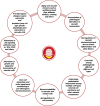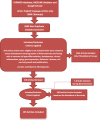Switching of vascular cells towards atherogenesis, and other factors contributing to atherosclerosis: a systematic review
- PMID: 33132762
- PMCID: PMC7592591
- DOI: 10.1186/s12959-020-00240-z
Switching of vascular cells towards atherogenesis, and other factors contributing to atherosclerosis: a systematic review
Abstract
Background: Onset, development and progression of atherosclerosis are complex multistep processes. Many aspects of atherogenesis are not yet properly known. This study investigates the changes in vasculature that contribute to switching of vascular cells towards atherogenesis, focusing mainly on ageing.
Methods: Databases including PubMed, MEDLINE and Google Scholar were searched for published articles without any date restrictions, involving atherogenesis, vascular homeostasis, aging, gene expression, signaling pathways, angiogenesis, vascular development, vascular cell differentiation and maintenance, vascular stem cells, endothelial and vascular smooth muscle cells.
Results: Atherogenesis is a complex multistep process that unfolds in a sequence. It is caused by alterations in: epigenetics and genetics, signaling pathways, cell circuitry, genome stability, heterotypic interactions between multiple cell types and pathologic alterations in vascular microenvironment. Such alterations involve pathological changes in: Shh, Wnt, NOTCH signaling pathways, TGF beta, VEGF, FGF, IGF 1, HGF, AKT/PI3K/ mTOR pathways, EGF, FOXO, CREB, PTEN, several apoptotic pathways, ET - 1, NF-κB, TNF alpha, angiopoietin, EGFR, Bcl - 2, NGF, BDNF, neurotrophins, growth factors, several signaling proteins, MAPK, IFN, TFs, NOs, serum cholesterol, LDL, ephrin, its receptor pathway, HoxA5, Klf3, Klf4, BMPs, TGFs and others.This disruption in vascular homeostasis at cellular, genetic and epigenetic level is involved in switching of the vascular cells towards atherogenesis. All these factors working in pathologic manner, contribute to the development and progression of atherosclerosis.
Conclusion: The development of atherosclerosis involves the switching of gene expression towards pro-atherogenic genes. This happens because of pathologic alterations in vascular homeostasis. When pathologic alterations in epigenetics, genetics, regulatory genes, microenvironment and vascular cell biology accumulate beyond a specific threshold, then the disease begins to express itself phenotypically. The process of biological ageing is one of the most significant factors in this aspect as it is also involved in the decline in homeostasis, maintenance and integrity.The process of atherogenesis unfolds sequentially (step by step) in an interconnected loop of pathologic changes in vascular biology. Such changes are involved in 'switching' of vascular cells towards atherosclerosis.
Keywords: Ageing; Atherogenesis; Atherosclerosis; Changes in vasculature; Gene expression; Inflammation; Oscillatory blood flow; Signaling pathways; Vascular homeostasis; Vascular microenvironment.
© The Author(s) 2020.
Conflict of interest statement
Competing interestsThe author declares that he has no competing interests.
Figures


Similar articles
-
Postprandial lipoproteins and the molecular regulation of vascular homeostasis.Prog Lipid Res. 2013 Oct;52(4):446-64. doi: 10.1016/j.plipres.2013.06.001. Epub 2013 Jun 15. Prog Lipid Res. 2013. PMID: 23774609 Review.
-
The benign nature and rare occurrence of cardiac myxoma as a possible consequence of the limited cardiac proliferative/ regenerative potential: a systematic review.BMC Cancer. 2023 Dec 18;23(1):1245. doi: 10.1186/s12885-023-11723-3. BMC Cancer. 2023. PMID: 38110859 Free PMC article.
-
Integrative pathway dissection of molecular mechanisms of moxLDL-induced vascular smooth muscle phenotype transformation.BMC Cardiovasc Disord. 2013 Jan 16;13:4. doi: 10.1186/1471-2261-13-4. BMC Cardiovasc Disord. 2013. PMID: 23324130 Free PMC article.
-
The role of epigenetics in the endothelial cell shear stress response and atherosclerosis.Int J Biochem Cell Biol. 2015 Oct;67:167-76. doi: 10.1016/j.biocel.2015.05.001. Epub 2015 May 13. Int J Biochem Cell Biol. 2015. PMID: 25979369 Free PMC article. Review.
-
Targeting tumor micro-environment for design and development of novel anti-angiogenic agents arresting tumor growth.Prog Biophys Mol Biol. 2013 Nov;113(2):333-54. doi: 10.1016/j.pbiomolbio.2013.10.001. Epub 2013 Oct 15. Prog Biophys Mol Biol. 2013. PMID: 24139944 Review.
Cited by
-
Dynamin-Related Protein 1 Binding Partners MiD49 and MiD51 Increased Mitochondrial Fission In Vitro and Atherosclerosis in High-Fat-Diet-Fed ApoE-/- Mice.Int J Mol Sci. 2023 Dec 23;25(1):244. doi: 10.3390/ijms25010244. Int J Mol Sci. 2023. PMID: 38203413 Free PMC article.
-
FAM3A mediates the phenotypic switch of human aortic smooth muscle cells stimulated with oxidised low-density lipoprotein by influencing the PI3K-AKT pathway.In Vitro Cell Dev Biol Anim. 2023 Jun;59(6):431-442. doi: 10.1007/s11626-023-00775-1. Epub 2023 Jul 20. In Vitro Cell Dev Biol Anim. 2023. PMID: 37474885
-
Investigation of the interplay of PCSK9, cardiac dynamics, oxidative stress in coronary artery disease: case-control study.Front Endocrinol (Lausanne). 2025 Apr 28;16:1494438. doi: 10.3389/fendo.2025.1494438. eCollection 2025. Front Endocrinol (Lausanne). 2025. PMID: 40357205 Free PMC article.
-
Porphyromonas gingivalis Induces Proinflammatory Cytokine Expression Leading to Apoptotic Death through the Oxidative Stress/NF-κB Pathway in Brain Endothelial Cells.Cells. 2021 Nov 5;10(11):3033. doi: 10.3390/cells10113033. Cells. 2021. PMID: 34831265 Free PMC article.
-
Statins in Chronic Kidney Disease-Effects on Atherosclerosis and Cellular Senescence.Cells. 2023 Jun 21;12(13):1679. doi: 10.3390/cells12131679. Cells. 2023. PMID: 37443712 Free PMC article. Review.
References
-
- Wu H, Roks AJ. Genomic instability and vascular aging: a focus on nucleotide excision repair. Trends Cardiovasc Med, 2014. 24(2):61–8. 10.1016/j.tcm.2013.06.005 Epub 2013 Aug 15. - PubMed
LinkOut - more resources
Full Text Sources
Research Materials
Miscellaneous

